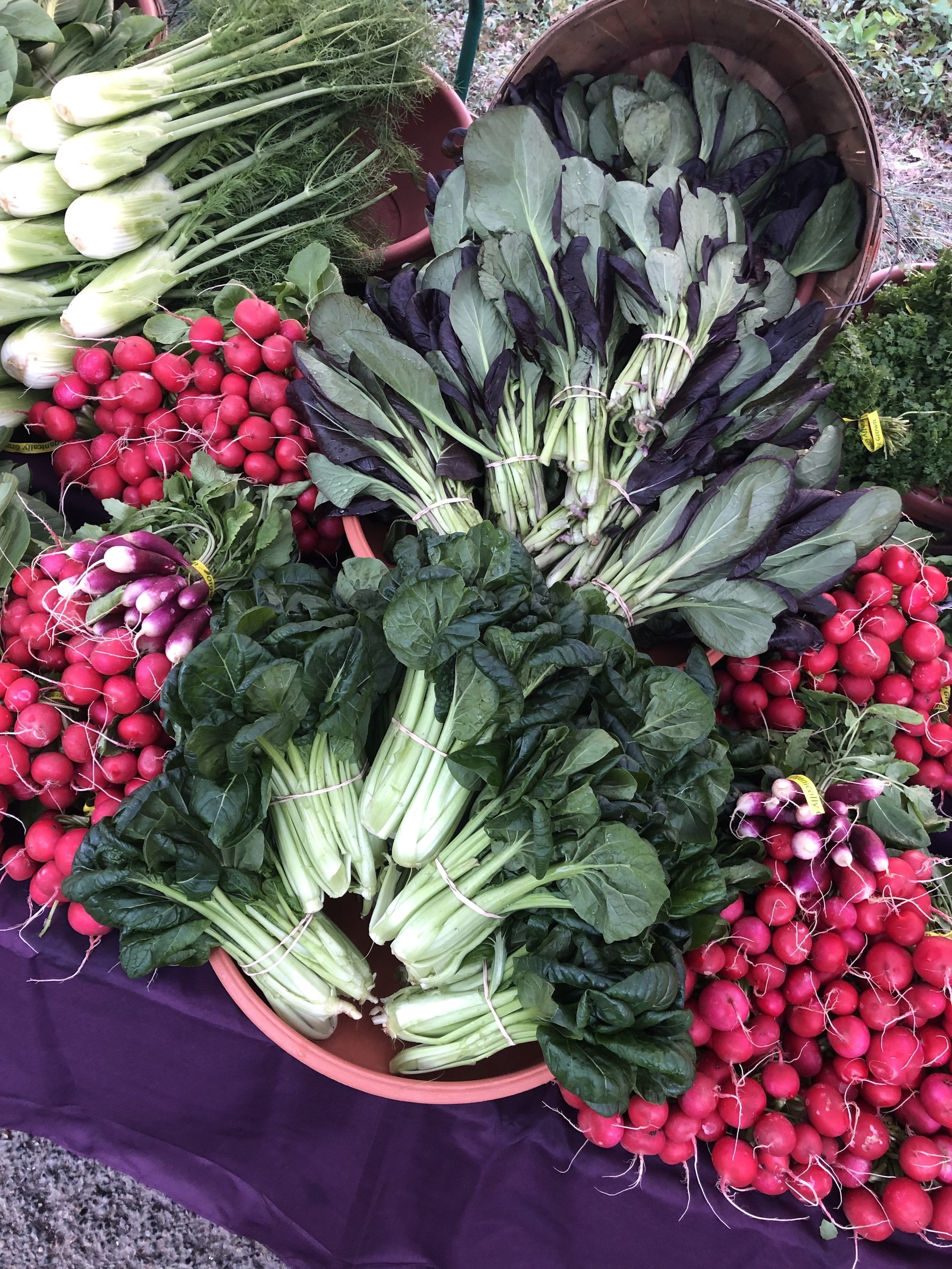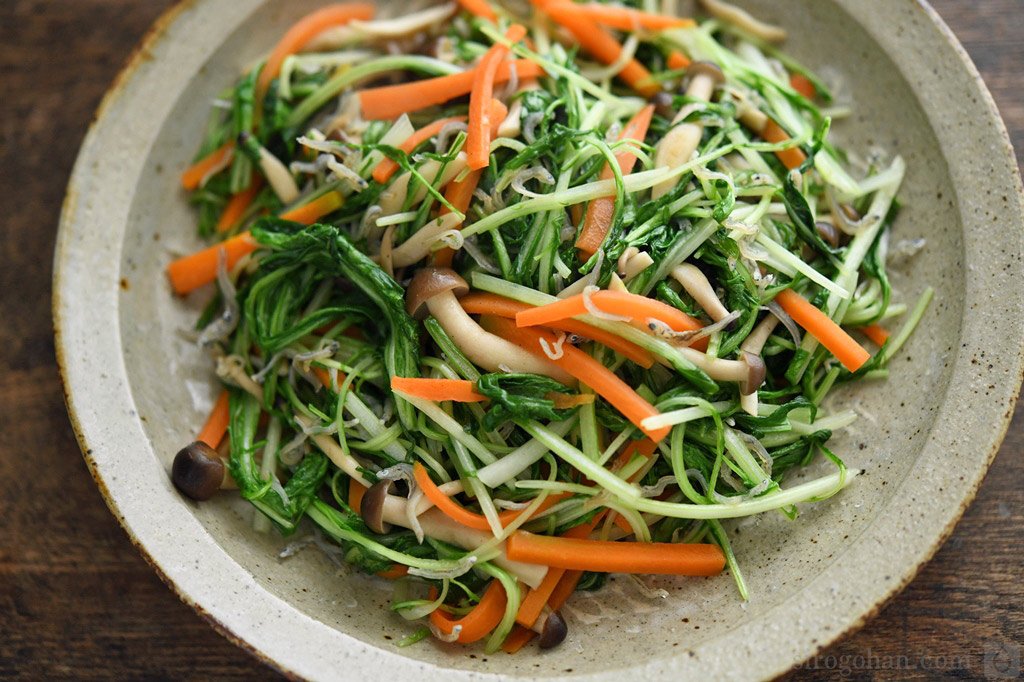Mustards and Asian Greens
Greens in the Brassica family tend to fall into two categories—hearty greens, which includes our kales and collards, and more delicate greens, including mustards and Asian greens. This includes super succulent yet mild and juicy bok choy, tatsoi, and Chinese mustard greens, as well as peppery and delicate greens such as mizuna mustard, arugula, and watercress. And just as the term “mustards” suggests, the mustard condiment that we all have in the fridge is indeed made from the seeds of mustard plants.
Both mustard greens and Asian greens can be cooked and enjoyed in similar ways. They lend themselves well to stir-fries, soups, and salads, but each have its unique traits highlighted when cooked in different ways.
Red & Green Mustard Greens
Mizuna mustard greens are known for having particularly thin stems and frilly, dissected leaves. Green mizuna is pretty mild, but both red mizunas tend to be pretty peppery, perfect in salads with fresh cheese, fruit, and maybe a honey lemon dressing. As with all mustards and Asian greens, mizuna mustards are also great in stir-fries and served with rice.
Similar to mizuna in flavor but with generally larger, rounder leaves and larger stems are a multitude of red and green mustards, including the deep purple Dragon’s Tongue Red Mustard and the light green to white Bekana Mustard. They can be cooked up exactly the same way and will just vary slightly in texture and flavor.
Mustard raab is a particularly wonderful spring treat as well, with juicy peppery florets that make a great sauté served alongside rice or underneath a couple fried eggs for breakfast.
Arugula & Watercress
While mizuna and other mustard greens tend to be a little more obscure, items that one generally would not find at a large grocery store, arugula and watercress are a whole lot more common. Both have delicate leaves, a vibrant green color, and a strong peppery flavor.
Watercress, also known as Berro in Spanish, is native throughout the Americas and can be found growing along riversides and stream beds. Indigenous and Latinx communities have long harvested watercress as one of many Quelites—highly nutritious wild-growing greens and herbs.
Watercress is such a delicate green with a high nutrient content, you don’t want to cook it for too long. It’s absolutely satiating just barely wilted or simmered in a rich broth or soup, and when used as a bed under a couple of fried eggs in the morning, the heat from the eggs alone wilts the greens to perfection. While stems are edible and included in cooking the majority of the time, there is a point later in the season that they get a little large and woody and are better removed.
Arugula comes in a variety of leaf shapes, from round to super lobey and arrow-shaped. But no matter what leaf shape or variety of arugula you find, you’ll get a super delicate light green leaf that packs a pungent peppery punch.
Asian Greens
From bok choy to tatsoi to Chinese mustard greens, these greens all have particularly succulent, sweet stems and mild to lightly peppery greens, perfect for stir-fries, ramen, and soups.
Baby Bok Choy, also known as Shanghai bok choy, is known for being that perfect little bok choy that can be cut into halves to maintain their beautiful shape on a dish. When cooked in the frying pan, add some soy sauce or tamari to the pan along with some oil and garlic. Let cooked side get golden brown before flipping over and serve on top of white rice, pouring the remaining juices from the pan over top. For soups, simply plop into the pot once the soup is done and let simmer until soft before serving.
There is a great variety of sizes and shades of bok choy, but they all have those thick juicy stems we all love and crave.
And we’re not the only ones who love them. Bok choy is really slugs’ favorite vegetable. When you’ve spent years washing vegetables and watching what collects at the bottom of the drain or crawls up out of the wash tank, you know. As hard as we try to wash them away, odds are you will find a slug in your bok choy, sometimes before and sometimes after you’ve chopped through it. Just saying, keep an eye out & enjoy.
Tatsoi is pretty much just like bok choy, only the stems are a little thinner and the leaves are a lot more robust, much like a spinach. Purple tatsoi varieties tend to have particularly then stems and a deeply vibrant purple color. The diversity of bok choy’s and tatsoi’s in this world is insanely beautiful, and is always one of my favorite sections to look at in seed catalogues. Baker Creek Heirloom Seeds has a particularly beautiful selection, and Quail Seeds has a gorgeous pink mid-rib variety called Vibrant Joy Bok Choy available.
There are many, many other Asian greens and mustards that are common in communities around the world. A Visual Guide to 10 Varieties of Asian Greens by Christine Gallary includes Gai Lan (also known as Chinese broccoli), Yau Choy, and Gai Choy (also known as Chinese mustard greens).
Beyond Bok Choy: Other Shades of Green by Kian Lam Kho speaks to the diversity of greens beyond bok choy, while also giving us a delicious recipe for Stir-fried Mustard Greens with Crabmeat. Kian’s website, titled the “Red Cook is about Chinese home style cooking. It is about sharing the joy and frustration of cooking Chinese food at home. It is also about making authentic Chinese food in America using local and imported ingredients. I have been cooking Chinese food in America for more than two decades and have learned to adapt. Here I share what I’ve learned and created, while looking forward to learning from readers through their comments.”










































This very simple dish is absolutely delicious and filling every time, bringing out the best of bok choy, especially when topped with a couple fried or soft-boiled eggs, kimchi, and a dollop of chili oil!